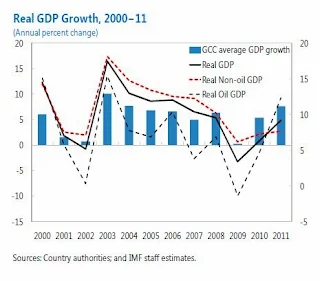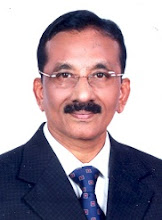The UAE economy is gradually recovering from the 2009
crisis. The banking sector was strengthened through significant capital
injections, and some progress has been made in restructuring the debt of
government-related entities (GRE). The ailing real estate sector is beginning
to find bottom but, given the ongoing oversupply, an early and broad-based
recovery of the sector remains unlikely.
Outlook and risks. The recovery of the nonhydrocarbon
economy, however, looks set to continue this year, backed by strong trade,
tourism, logistics, and manufacturing, and helped by high oil prices. With
limited near-term potential for further increases in real oil production, overall
GDP growth is expected to moderate to 2.3 percent. Downside risks relate to a
possible increase in regional geopolitical tensions, a potential decline in oil
prices, a renewed worsening of global financial conditions, or a marked
slowdown in Asia.
Macroeconomic policy mix. The UAE plans a gradual fiscal
consolidation this year which will help unwind the fiscal stimulus of recent
years and lower the currently high fiscal breakeven oil price without
undermining the economic recovery. The planned fiscal consolidation will also
increase the room for maneuver in case the downside risks materialize. Monetary
policy will stay appropriately accommodative under the U.S.dollar peg.
Government-related entities. The GREs continue to face
financial challenges in light of their high debt and rollover needs. Further
deleveraging and strengthening of impaired GRE balance sheets is needed.
Improving GRE corporate governance and increasing transparency about their
financing strategies, financial conditions, and debt profile would be important
to strengthen market confidence. Channeling bank funding to non-viable GREs
should be avoided.
Financial stability. The banking system maintains
significant buffers to withstand a further deterioration in asset quality and
external liquidity conditions. The central bank should nonetheless continue to
closely monitor banks’ liquidity and capital buffers as individual banks could
be affected if downside risks materialize.
Statistics. Effective policymaking is contingent on
timely and accurate data, rendering further improvements in the statistical
framework important
BACKGROUND
1. Following the 2009 crisis, the economy has been slowly
recovering and repairing its balance sheets. The Dubai World debt restructuring
was completed, but several other troubled government-related entities (GRE) are
still in the process of restructuring. The authorities strengthened the banking
sector through liquidity support, recapitalization, and deposit guarantees, and
the emirate of Abu Dhabi provided financial support to the emirate of Dubai.
The Dubai Financial Support Fund (DFSF) was called to support troubled entities
in the emirate and has now almost exhausted its funding of $20 billion.
2. The UAE has been reaping the benefits of its early
efforts to diversify the economy. As the UAE developed into a major services
hub in the Middle East, its dependency on oil exports declined markedly.
Based on its well-developed hospitality and services
sectors, tourism, transportation and logistics have been major drivers of the
post- 2009 recovery. The UAE has also been benefiting from high oil prices and
strong growth in Asia. As a result of its perceived safe haven status and
developed services sector, the country benefited from an increase in demand for
property by expatriates and a
surge in tourism in the wake of the turmoil in the MENA
region that began last year.
Recent Developments
3. The economic recovery continued and the external
position strengthened significantly in 2011. Real GDP growth reached an
estimated 4.9 percent, supported by high oil prices and production in response
to disruptions in Libya. Nonhydrocarbon growth also strengthened, to around 2.7
percent, backed by strong trade, logistics and a surging tourism sector,
despite the continued weakness of the construction and real estate sectors in
the aftermath of the 2009 crisis. Backed by high oil prices and buoyant
Nonhydrocarbon exports, the external current account surplus increased
markedly, to around 9 percent of GDP. Inflation remained subdued at an average
of 0.9 percent in 2011, mainly due to a continuing decline in housing rents and
limited pass-through of international food prices.
4. The large property overhang continues to be a drag on
the economy. Since mid-2008, real estate prices have fallen by more than 60
percent in Dubai, and to a lesser extent in Abu Dhabi. The large supply
overhang and the completion of additional projects in the coming years render
an early and broad-based recovery of the sector unlikely (Box 1).increased its
current and development expenditures, and extended substantial financial
support to Aldar, its flagship real estate developer.2 Following a contraction
in 2010, Dubai’s deficit increased slightly in 2011, mostly on account of
further spending from the DFSF. Nonetheless, high oil prices led to an improvement
in the consolidated overall balance from a deficit of 2.1 percent of GDP in 2010
to an estimated surplus of 2.9 percent of GDP in 2011.
5. The recovery
was supported by an expansionary fiscal policy. The consolidated government
nonhydrocarbon primary deficit (including loans and equity) rose to nearly 42
percent of nonhydrocarbon GDP in 2011 (from 36 percent in 2010), as Abu Dhabi increased
its current and development expenditures, and extended substantial financial
support to Aldar, its flagship real estate developer.2 Following a contraction
in 2010, Dubai’s deficit increased slightly in 2011, mostly on account of
further spending from the DFSF. Nonetheless, high oil prices led to an improvement
in the consolidated overall balance from a deficit of 2.1 percent of GDP in 2010
to an estimated surplus of 2.9 percent of GDP in 2011.
6. Supported by accommodative monetary policy, banks
remained amply liquid but private sector credit growth did not pick up. In
light of low U.S. interest rates, monetary policy stayed accommodative under the
fixed exchange rate regime. Lending to the private sector has nonetheless
remained sluggish and lagged behind the recovery in credit growth in
neighboring GCC countries, as
excess capacity in the real estate sector and the debt
overhang still limit lending opportunities. Despite a continued rise in nonperforming
loans (second highest level among GCC countries), the banking sector has remained
well-capitalized and profitable, as the net interest margin has remained
comfortable. In October 2011, the authorities quickly
resolved Dubai Bank through a takeover by Emirates NBD bank
1 The Dubai Financial
Support Fund, financed in equal parts by the central bank and Abu Dhabi, was established
in 2009 to provide financial support and liquidity to government and
government-related entities undertaking projects of strategic importance in Dubai.
2 The consolidated
government comprises the federal, Abu Dhabi, Dubai, and Sharjah governments accounting
for over 99 percent of total UAE fiscal expenditures.
3 In connection with this
transaction, Emirates NBD received a Dh2.8 billion deposit from the ministry of
finance. The government of Dubai has provided a guarantee—with a fair value of
Dh768 million—for any losses relating to existing assets for seven years.




1 comment:
SA Rawther Spices is the largest processor and exporter of black pepper and dry ginger in India, apart from having a good track record in the international trade of coffee, turmeric, cloves, chillies, nutmeg and other products.
TURMERIC
Botanical names: Curcuma longa
Family name: Zingiberaceae
Turmeric “the golden spice of life” is one of most essential spice used as an important ingredient in culinary all over the world. Turmeric, basically a tropical plant of ginger family is the rhizome or underground stem, with a rough, segmented skin. A yellow spice with a warm and mellow flavor, it is mildly aromatic and has scents of orange or ginger.
FOR MORE DETAILS VISIT : http://rawther.co.in/
Post a Comment